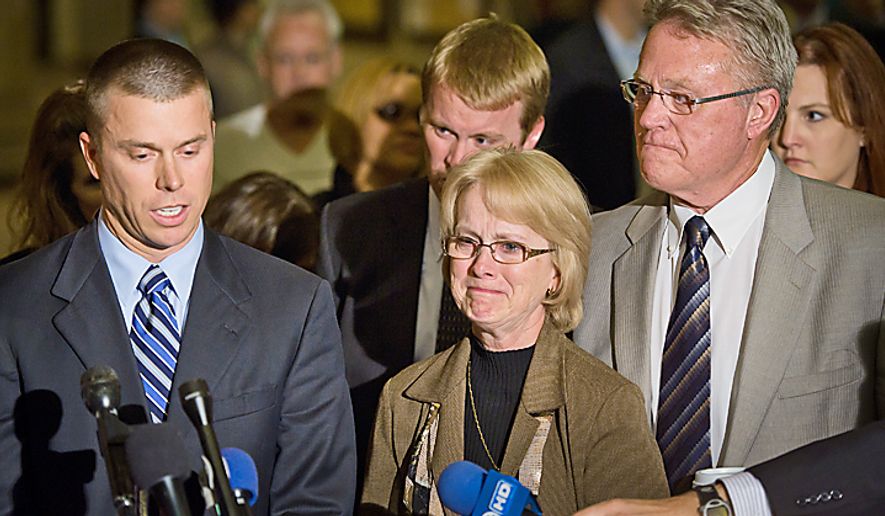A Montgomery County jury on Wednesday evening found Brittany Norwood guilty of first-degree murder in the horrific slaying of her co-worker at the Lululemon Athletica store in Bethesda.
The six-day trial, which detailed a vicious killing and the dramatic twists and turns of an investigation into an elaborate cover story and a morbidly staged crime scene, ended with the jury presenting its verdict close to 7 p.m. after a little more than an hour of deliberation.
As the verdict was read Wednesday night, an audible “yes” could be heard from the family of the victim, Jayna Murray.
“I want no other family to go through this,” Murray’s mother, Phyllis Murray, said in the foyer to the Montgomery County courthouse afterwards. “The brutality was undescribable.”
Norwood’s family remained silent when the verdict was read. They declined to comment.
Judge Robert A. Greenberg instructed the jury to decide first whether Norwood was guilty of first-degree murder, which requires jurors to believe the crime was premeditated. The guilty verdict on that charge means Norwood faces life in prison without the possibility of parole when she is sentenced Jan. 27.
“That is precisely the sentence we will be seeking from Judge Greenberg at that time,” State’s Attorney John McCarthy said.
If the jury could not agree on first-degree murder, they were told they could convict Norwood on a lesser second-degree murder charge.
Afterward, one juror said the six-man, six-woman panel agreed immediately on the first-degree murder conviction.
“I asked who thought it was first-degree, and everybody’s hand just went up,” said juror Donny Knepper, a 36-year-old criminal defense lawyer.
Norwood’s defense attorney, Douglas Wood, said the Norwood family was disappointed with the verdict.
“I thought I established a pretty good case for second-degree murder,” Mr. Wood said after the verdict was delivered.
Asked about his strategy, admitting in opening statements that his client killed the victim and calling no witnesses in her favor, Mr. Wood said Norwood was “fine with our defense.”
“You deal with the evidence and you put on your best defense,” he said.
In closing arguments, Mr. Wood seized on the fact the prosecution has been unable to discuss any possible motive in the March killing as evidence Norwood did not plan to kill Murray.
“That day there was nothing going on between Jayna Murray and Brittany Norwood,” Mr. Wood said. “The absence of a motive is an indication it’s not premeditated. That is not a crime of motive. That is a crime of passion.”
Before the trial, prosecutors disclosed their belief that Murray confronted Norwood on March 11 over stolen merchandise. However, the judge disallowed discussion of the potential motive during the trial as hearsay.
The crime occurred after the two women closed the store for the night. Prosecutors said Norwood lured Murray back to the yoga boutique in the upscale Bethesda Row shopping center under the guise she left her wallet there, and within five minutes of returning, Norwood attacked Murray from behind with a quick blow to the back of the head.
The vicious assault drew the attention of employees at a neighboring Apple store, who testified they heard 10 minutes of shouting and grunting, as well as pleas for help — but did not call police.
“People don’t go from zero to 60 in three minutes,” prosecutor Marybeth Ayres said in closing arguments.
Prosecutors spent a good portion of the trial detailing the lengths Norwood went in order to cover her tracks.
After the murder, she staged the crime scene using items from the store so it appeared she and Murray were assaulted during a robbery. Norwood used men’s shoes to track Murray’s blood through the store, she took money from the cash registers, and she cut herself and tied herself up so she could claim she was raped.
Addressing the multiple ways that Norwood, 29, staged the crime scene and how she lied to investigators, Mr. Wood called his client “delusional.”
“Is that the story of someone who is cunning? The story makes no sense,” he said of Norwood’s tale that she also left the store at the request of her attackers to move Murray’s car but did not go for help. “It’s someone who cannot figure out what to do after they have killed someone.”
Mr. Wood argued that Norwood killed Murray as the two argued and Norwood “lost it.”
“I think if you just ’lose it’ you stick with the same weapon,” Mr. McCarthy said, discussing the multiple weapons — including a hammer, knife, merchandise peg, rope and box cutter — believed to have been used in the slaying. “There is a conscious decision to rearm because what you’re doing is not getting the job done.”
The last witness to testify in the case, deputy medical examiner Mary Ripple, said Wednesday morning that at least five weapons caused the 331 identifiable wounds she documented across Murray’s body.
Autopsy photos of Murray showed 37 cuts on her badly bruised head and face and the likely death blow — a stab wound in the back of her neck that cut through to her brain.
“That area of your brain is pretty critical to you being able to function. She wouldn’t have lived very long after that,” said Dr. Ripple, adding she believed Murray was alive for most of the blows.
“She would not have been able to have any voluntary movement to defend herself,” she said.
• Andrea Noble can be reached at anoble@washingtontimes.com.




Please read our comment policy before commenting.